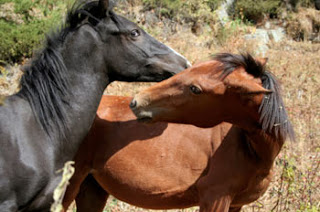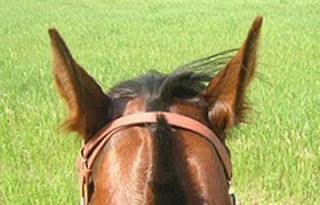
Black horse: fear eye, backing up, head high, "Oops, sorry"
Horse whisperers take note: If you want to better understand your equine friends, then study their ears.
A study has revealed that just like humans, horses read each other's faces. But, unlike us, they gain important information by specifically examining the ears. It seems that when a horse is interested in something, it pricks up its ears and swivels them towards whatever has caught its attention. This movement is so important that, if its ears are covered up, another horse struggles to know what it is thinking.

They almost always took their cue from the pictured animal and chose the bucket it seemed to be looking at. However, when the photo was manipulated, so that the horse's eyes were covered up, the results were no better than chance.
This suggests the horse's gaze conveys important information.
More surprisingly, covering up the ears had the same effect - meaning they are also key to communication. Researcher Jennifer Wathan (CORR), a PhD student, said: 'Our study is the first to examine a potential cue to attention that humans do not have: the ears.
Ear movements translated
Horses have very mobile ears, they can only swivel them round, point them forward, pull them up or flatten them back.
When a horse's ears are flopping down, it means the creature is relaxed.
But pinned back, and the horse is expressing anger.
When a horse is interested in something, it pricks up its ears and swivels them towards whatever has caught its attention.
The ability to read each other's interest level is disrupted when the ears are covered up, the researchers found.

For those who want to conduct their own field experiments, a relaxed horse flops down its ears, while it is thought an angry animal pins them back.
Miss Wathan, a psychologist, said: 'Although horses have very mobile ears, they can only swivel them round, point them forward, pull them up or flatten them back. 'Cats and dogs have more movements.' She added that a greater understanding of how horses communicate could help improve their welfare.



Every horse wrangler, and likely almost every horse owner too, knows this about horses. Yet, of course the academics have to write a paper about it.